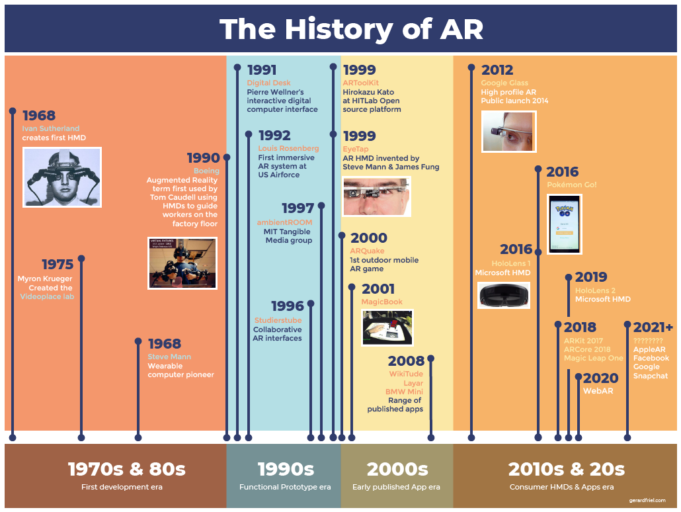Augmented Reality – fifty years in the making!
What is AR?
Augmented Reality or AR is the addition of a digital layer to the real world’s physical environment. You can still see your real environment, but it’s enhanced (or augmented) with additional computer generated items. AR differs from its cousin Virtual Reality (VR) as VR completely substitutes your real world view with a completely digital environment.
Although slightly younger than VR, AR has history spanning half a century. It started with the first developments in the seventies and eighties, continued with the functional prototypes and early applications of the nineties and noughties, and led us to the apps and equipment launches of today.
AR Timeline

First development era (1970s & 80s)
- Ivan Sutherland (1968) – after experiments with three-dimensional displays at MIT, Sutherland developed the first Head Mounted Display (HMD).
- Myron Kruegar (1975) – created the responsive environment of the Videoplace Lab.
- Steve Mann (1980s) – known as the father of ‘wearable computers’, his research and developments would influence the future of AR.
Functional prototype era (1990s)
- Boeing (1990) – first used the term ‘Augmented Reality’ in a project that used HMDs to guide workers on the factory floor.
- Pierre Wellner (1991) – the interactive projection-based Digital Desk
- Louis Rosenberg (1992) – US Airforce immersive AR system called Virtual Fixtures
- Studierstube (1996) – development of a collaborative AR interface
- MIT (1997) – ambientROOM moves digital content and interfaces into the background envinronment
- Kirokazu Kato (1999) – ARToolkit open source platform opens up AR development
- Steve Mann (1999) – along with James Fung develops the precursor to Google Glass with the EyeTap prototype
Early published App era (2000s)
ARQuake (2000) – the first outdoor mobile AR game
MagicBook (2001) – using AR with printed material
Various apps (2008) – including AR Travel Guide Wikitute, BMW Mini, and Layar
Consumer hardware & Apps era (2010s)
Google Glass (2012) – high-profile wearable AR
HoloLens 1 (2016) – Microsoft’s HMD
Pokemon Go! (2016) – Popular location-based game
Magic Leap 1 (2018) – Magic Leap’s HMD
HoloLens 2 (2019) – Microsoft’s 2nd generation HMD
iPad Pro (2020) – Apple includes the real-time LiDAR scanner
What’s next?
Software development and hardware improvements will provide users with a larger number of AR experiences to choose from. With the release of Google and Apple’s AR SDK ARCore and ARKit respectively, the consumer app market is well placed to utilise developments in wearable technology. These devices include Spectacles from Snapchat and possibly AR glasses from Apple.
